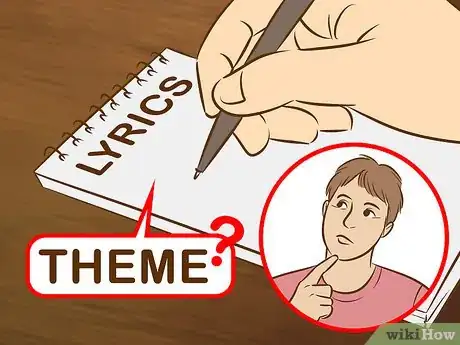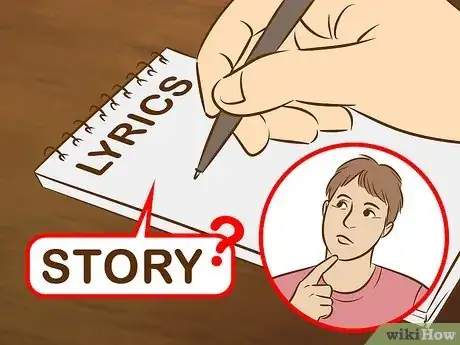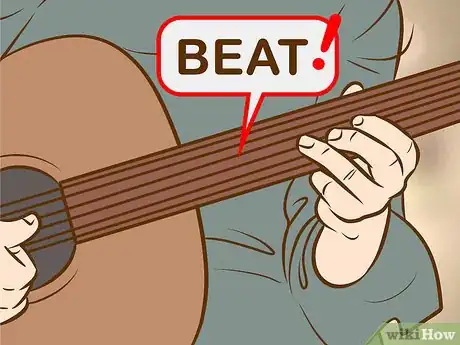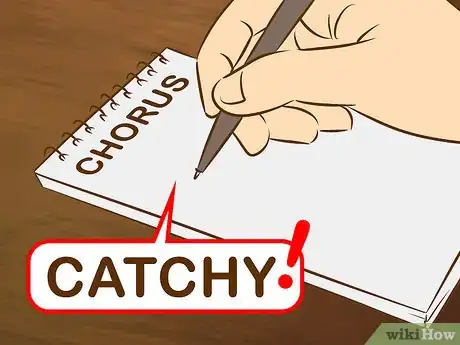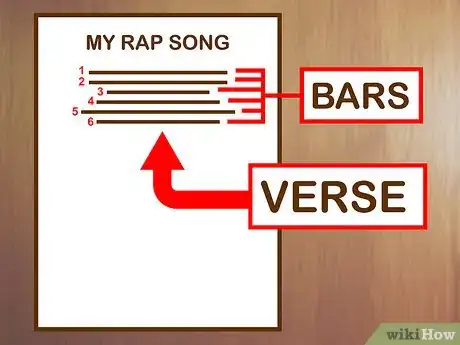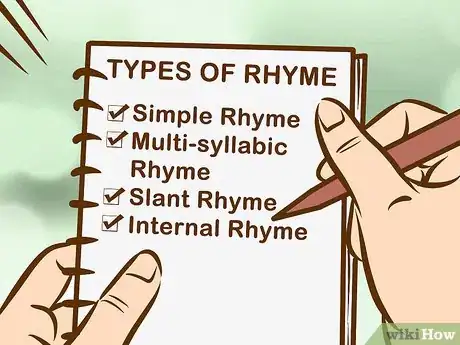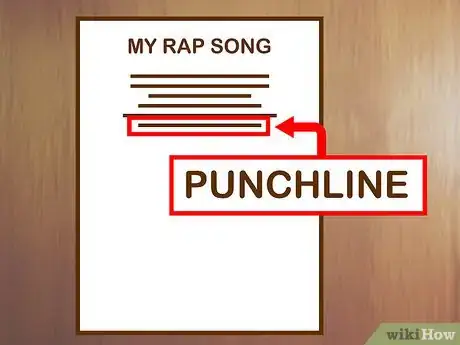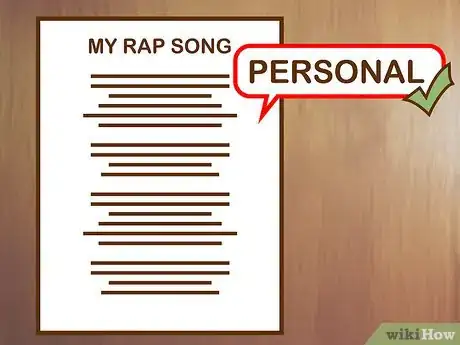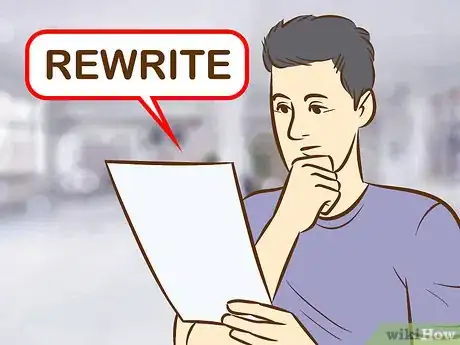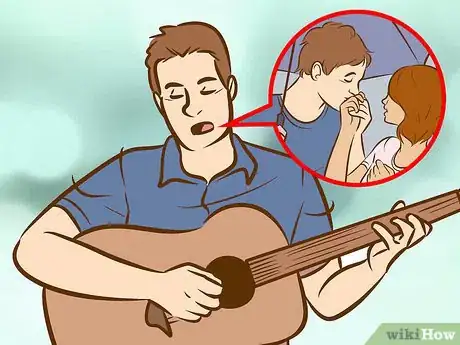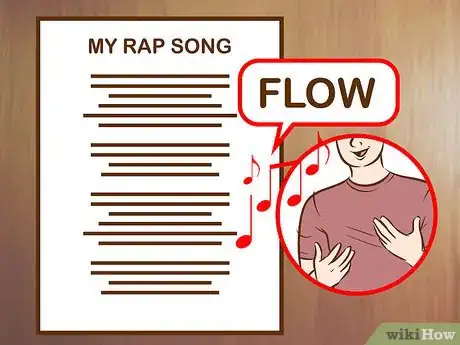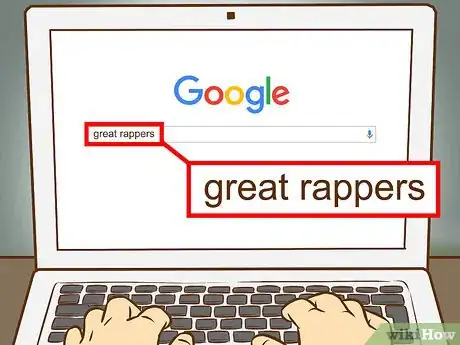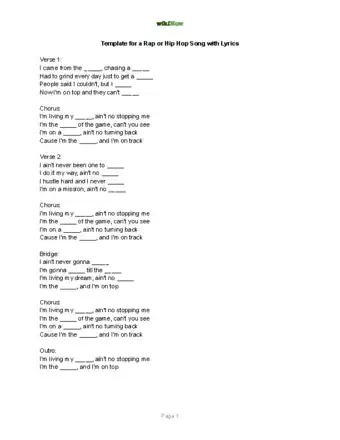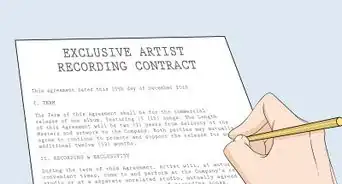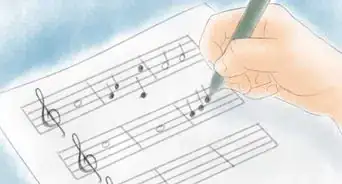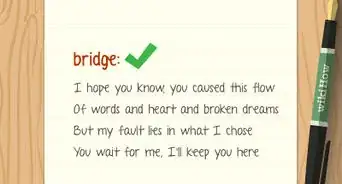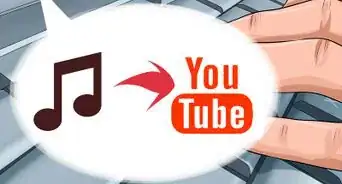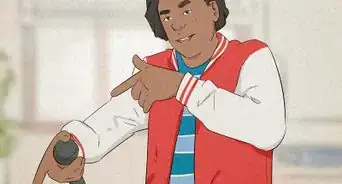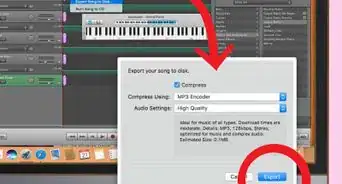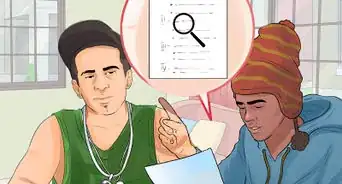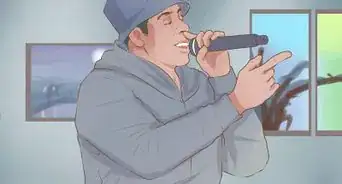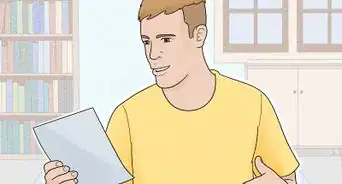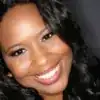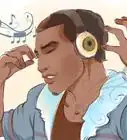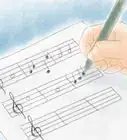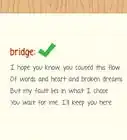This article was co-authored by Tanisha Hall. Tanisha Hall is a Vocal Coach and the Founder and Executive Director of White Hall Arts Academy, Inc. an organization based in Los Angeles, California that offers a multi-level curriculum focused on fundamental skills, technique, composition, theory, artistry, and performance at a conservatory level. Ms. Hall's current and previous students include Galimatias, Sanai Victoria, Ant Clemons, and Paloma Ford. She earned a BA in Music from the Berklee College of Music in 1998 and was a recipient of the Music Business Management Achievement Award.
wikiHow marks an article as reader-approved once it receives enough positive feedback. This article has 42 testimonials from our readers, earning it our reader-approved status.
This article has been viewed 1,058,131 times.
Rap is a modern form of poetry, and lyrics are what distinguish good rappers from great ones. Great rap lyrics are personal and flow like water, blending into the song while making a point or theme like a great essay or story might. Writing great lyrics takes practice, but anyone can start at any time with just a pen and a piece of paper.
Steps
Finding a Theme and Hook
-
1Come up with the theme for the song. The subject may be something that has recently happened, something that has happened in the past, an issue you are thinking about, etc. It may be a dance-type song, a song where you talk about yourself, or it may be something that happened in a dream. There are no wrong themes, as long as they come from personal experience somehow.
- The title of the song is a good indicator of its theme. However, you can always come up with the title later.
-
2Come up with the "story" of your lyrics. You don't have to tell an actual story, though story-raps have been popular since the birth of hip-hop (Immortal Technique's "Dance with the Devil," most Ghostface Killah songs). Telling a story just means your song or verse has a beginning, middle, and end. You want to take the listener on a journey, even if it is just a journey about how great and steezy you are.
- Some rappers write out their songs as paragraphs first, then write the songs and rhymes to follow the general structure.
- Having a structure to your song helps you build a coherent idea out. For example, your best point of biggest rhyme wouldn't come at the very beginning of a song, it would come near the end, like the climax of a good movie. This will help you engage and hold listeners.[1]
- At the very least, try and end your song on a different place than where you started. This is why even "material rap" about gold and girls often starts by mentioning how little the rapper had when they first started working.
Advertisement -
3Get to know your beat. Make sure that the beat you choose is one you're comfortable with. For example, if you can't rap very fast, you may not want to choose a fast beat, as you won't be able to rap over it without losing your breath or stuttering. Listen to the beat 4-5 times to get comfortable with the rhythm and the mood of the song. Get a feel for the speed and energy of the song as well as the mood.
- Uptempo songs (Das Racist, "People are Strange") usually require fast verses with lots of words, while slower beats (50 Cent, "P.I.M.P.") usually have laid back verses. This rule is not hard and fast, however (see Twista on "Slow Jamz," for example).
- When lyrics matches the beat, great songs are born. Think about how the beat makes you feel-- is it tense and atmospheric, like Jay-Z's "Renegade," or is it upbeat and celebratory, like Kanye's "The Glory?" Notice how the lyrics in these songs match the beat.
- Listen again to A$AP Rocky's "One Train," where five unique rappers have verses over the same beat. Note how each one approaches the song differently: some urgent (Kendrick), some joyful (Danny Brown), some angry (Yelawolf), some contemplative (Big K.R.I.T.). All of them, however, fit into the beat.
- You do not need to have a beat to start writing raps. It can help to write your lyrics without a beat in mind, then save them until the right beat comes along.
-
4Write a catchy hook or chorus. This is the repeated phrase in the middle of the song, separating each verse. They are not strictly necessary (see A$AP Rocky's "One Train"), but almost any rap song that wants to gain radio play or traction needs a good catchy hook. It can range from something very deep to something that's just catchy, and it almost always reinforces the theme of the song. Many hooks are sung, not rapped.
- 50 Cent is a master hook writer, and songs like "P.I.M.P." and "In Da Club" have hooks that are still sung over 10 years later.
- For an easy, classic hook, try coming up with 1-2 separate, simple, rhyming phrases. Repeat them each twice, back to back, for the "classic" chorus. Like this catchy hook, repeated in its entirety twice:
- Cigarettes on cigarettes my momma think I stank
- I got burn holes in my hoodies all my homies think it's dank
- I miss my cocoa butter kisses... cocoa butter kisses.-- Chance the Rapper, "Cocoa Butter Kisses"
Writing Great Rhymes
-
1Figure out how many bars you have to rap on. A bar is simply one line of your song. Most raps are built out of 16 or 32 bar verses though they can be as short as 8 or 12 bars as well. If you're writing the whole song yourself you might have 2-3 verses and a hook. You might also have a short 8-10 bar bridge, which is a short verse with a slightly different beat or structure.
- You can write your rap without knowing the bars as well. Simply write until you feel like your verse is finished, then edit the beat to fit the desired length.
-
2Understand rhyme inside and out. Raps are written around rhymes. Rhyme connects to lines so that they flow smoothly together, pulling the listener through the song. While all lines of your rap don't need to rhyme, and probably should not, you need to have a firm grasp of rhyme techniques to become a rapper. Luckily, this doesn't require any studying, just an ear for what sounds good to you. Still, it can help to know the different types of rhyme common in rap:
- Simple Rhyme: When the last syllables of two lines rhyme, like "Can" and "man." This is the most common and basic form of rhyme.
- Multi-syllabic rhyme: One of the best ways to show your lyrical skills is to rhyme multiple syllables at once. This can stretch across multiple words as well, such as Big Daddy Kane in "One Day:" "Ain’t no need for wondering who’s the man/ Staying looking right always an exclusive brand."
- Slant Rhyme: Rhyming two closely related, but technically non-rhyming, words. Usually, they have a common vowel sound. This is incredibly common in rap, because how you say/sing the words can make them sound much more similar. Examples include "Nose" and "go," or "orange" and "porridge."[2]
- Internal Rhyme (In-Rhyme): Rhyming words that do not come at the end of a line but in the middle of it. For example, Madvillains' "Rhinestone Cowboy:" "Made of fine chrome alloy / find him on the grind he's a rhinestone cowboy."[3]
-
3Write "punchline raps" in reverse. Punchlines are the big lines, jokes, or rhymes that elevate the song from good to great. There are thousands of great examples, but they are mostly a matter of personal preference. To write them, try to think of the punchline first then build the rhyming lines around it.
- If your punchline is "I'm stepping over competition, so expect to be trampled," you might try to write a line leading into it that ends with a word rhyming with "trampled." For example, "They see me in the booth so they know they should scramble/ I'm steppin' over competition so expect to be trampled").
-
4Organize your lines into a rhyme scheme. A rhyme scheme is simply how the song is structured. The most common way to do this is with alternating couplets, which are two lines that rhyme at the end. The next two lines also rhyme at the end, but with a different set of words. That said, there are many, many ways to write out rhyme schemes, such as alternating (the first line rhymes with the third, and the second with the fourth), or rhyming 4-6 lines with the same word (like the beginning of "Get 'Em High"). The best way to learn is practice.
- If you're a rapper that raps with a lot of flow (smooth, quick words) you may want to have every bar end with the same amount of syllables or almost the same amount of syllables.
- If you're a rapper that raps fast you may want to have lots of internal rhymes in every bar, like " the industry's gettin' clean and I've seen what them haters mean/ if you thought I was lettin' up setting up the terrain was dreamed".
- If you're a story rapper you can have the first verse be your intro, your second verse your problem, and your last verse your conclusion. To match this, you might play with a different rhyme scheme in every verse to show growth or use a similar one to indicate that there is no growth.
-
5Make sure your song is personal and real. Make sure you mean every word and every word comes from your soul. Let the music come to you. To start writing good lyrics, you should throw on a beat that juices your brain start thinking of some insane rhymes. It's all about the state of mind.
- Specifics from real life will always make a better song. The reason Nas' Illmatic is one of the all-time great albums is because it feels lived in, not made up.
- If you don't have a theme or rhyme scheme yet, just start writing lines that you like. Eventually, these lines will come together to tell a full song, and this can be a great way to practice rhymes.
- The best rappers are able to tell stories from real life, connecting to their audience's memories and emotions. They are successful not because they tell crazy or unbelievable stories, but because they make a simple story connect with practice and well-written rhymes.
Improving Your Lyrics
-
1Practice rewriting your favorite raps. This is one of the best ways to learn rapping technique. Take your favorite songs and learn them forwards and backward. Then rewrite the rap, using the same rhyme scheme but with your own verses. This is how mixtapes first became popular, with rappers like Curren$y and 50 Cent taking popular songs, flipping them, and making them their own. Even if you never share the song, this is a great way to learn rap techniques naturally.
-
2Learn poetic techniques to up your game. Rap is poetry -- using words, sounds, and rhymes to create beautiful art and ideas. As such, it is no surprise that the best rappers have taken inspiration from the best poets. Eminem, for example, famously used Shakespearean meter and rhyme in many of his famous songs. Other examples include:
- Alliteration/Assonance: Words with similar sounds that are placed close together, like "Two tip-top teachers" or "apple attitudes." Listen to Joey Bada$$'s "Waves" for a great example.
- Simile/Metaphor: Closely connected, this is when writers compare two objects that aren't usually alike to make a point. For example -- "I put the metal to his chest like Robocop" works on multiple levels, bullets are made of metal, Robocop's chest is covered in metal armor, and the biggest target when shooting someone is their chest. This is a much more poetic way to imply "I might shoot him."[4]
- Refrain: A line that is repeated at various points for emphasis. The more you hear the line, the more it changes, evolves, and gains power. For a master class in how to use a refrain, see Kendrick Lamar's "The Blacker the Berry."
- Anaphora: When the first half of a line repeats, but the rest of the line changes, like in Eminem's "If I Had" where every line begins with "Tired of...." This is a great way to show how difficult, constant, or trying something may be, or overwhelm the listener intentionally.[5]
-
3Use specific imagery in your lyrics. Great imagery puts visuals behind the listeners' eyes, engaging multiple senses to create complex, engaging raps. The best rappers all conjure images up in your mind, telling stories and making their lyrics come alive. To do this, focus on being specific-- use adjectives and adverbs to make the images your own.
- This doesn't have to be purely visual imagery. Action Bronson uses foods and scents in his raps to give them an entirely new dimension.
- The kings of imagery, Andre 3000, Ghostface Killah, Eminem, etc. are often those rappers that gain the greatest followings.
-
4Work on the flow, or delivery, of your lines so that they work together to tell your story. Good lines become great lines with good flow. Flow is how you deliver the words in relation to the beat. Are you slow, holding back, or are you attacking the beat with speed and intensity. Do you waver up and down, picking up and slowing down depending on the line? Flow takes practice and patience, so put a beat on and practice.
- You don't have to have the same flow throughout the whole song. Nas's incredibly "NY State of Mind" flows like a great jazz solo -- stopping, starting, pausing and pushing forward around the incredible rhymes.[6]
-
5Read the great rappers for inspiration. Much like a burgeoning writer needs to study the best poets, a growing rapper needs to read to the best. Reading a rap lets you see it on the page, much like the rapper when they wrote the lyrics. This will help you comprehend rhyme schemes and little tricks. Sites like RapGenius, for example, even have annotated lyrics that explain metaphors, rhymes, and references. Listen to what you enjoy, but a small selection of essential verses (in addition to the other songs referenced in the article) to start with includes:
- AZ's, first verse on "Life's a B---", off of Nas's album Illmatic.
- Notorious B.I.G, "Notorious Thugs."
- Black Thought, "75 Bars (Black's Reconstruction).
- Rakim on "As the Rhyme Goes On," on Paid in Full.
- Kendrick Lamar, "Sing About Me, I'm Dying of Thirst."
- Lupe Fiasco, "Murals."
- Eminem, "Lose Yourself."
Template for a Rap or Hip Hop Song with Lyrics
Community Q&A
-
QuestionCan I be a good rapper even if I'm a bad singer?
 Community AnswerYes, rapping is more about the uniqueness of your flow and delivery than the quality of your voice itself.
Community AnswerYes, rapping is more about the uniqueness of your flow and delivery than the quality of your voice itself. -
QuestionIs rapping a skill that you are born with or something that you can learn?
 Community AnswerYou can definitely learn to rap, it just takes practice. You have to have an extensive vocabulary which can be learned by reading a multitude of different types of books.
Community AnswerYou can definitely learn to rap, it just takes practice. You have to have an extensive vocabulary which can be learned by reading a multitude of different types of books. -
QuestionHow do I know if the rap is going to be OK?
 Community AnswerAsk friends and family to listen to your piece. You could listen to other rap songs to become inspired.
Community AnswerAsk friends and family to listen to your piece. You could listen to other rap songs to become inspired.
Warnings
- Remember that your words have power, and you should always be honest and truthful to yourself when rapping.⧼thumbs_response⧽
- Your songs may be turned down or even laughed at but never let that stop you from doing what you do.⧼thumbs_response⧽
References
- ↑ http://www.musicindustryhowto.com/how-to-write-better-rap-lyrics-5-big-tips/
- ↑ http://genius.com/posts/24-Rap-genius-university-rhyme-types
- ↑ https://www.flocabulary.com/multies/
- ↑ https://www.platinumloops.com/how-to-rap-part-4-writing-great-rap-lyrics/
- ↑ http://genius.com/posts/24-Rap-genius-university-rhyme-types
- ↑ http://genius.com/Nas-ny-state-of-mind-lyrics/
About This Article
To write lyrics to a rap or hip hop song, start by coming up with a theme for the song that’s personal and real to you, like something that’s happened to you in the past or an issue you’re thinking about. Next, come up with a story with rhyming lyrics around your theme and structure it with a beginning, middle, climax, and ending. Then, tie your song together with a catchy hook or chorus like the one in Chance the Rapper’s “Cocoa Butter Kisses” or 50 Cent’s “In Da Club.” For more tips, like how to come up with great rhymes, read on!
